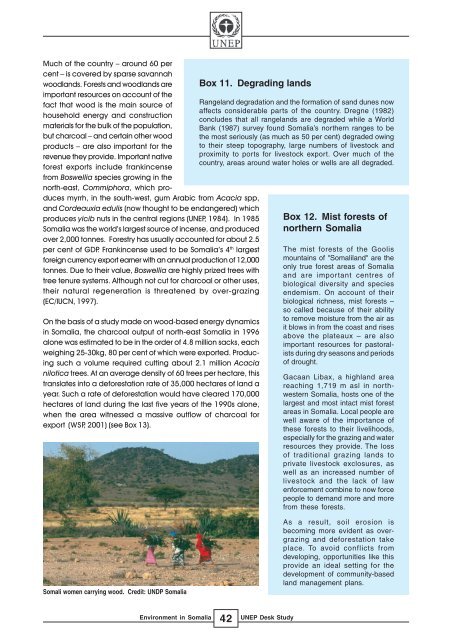state of the environment in Somalia - Disasters and Conflicts - UNEP
state of the environment in Somalia - Disasters and Conflicts - UNEP
state of the environment in Somalia - Disasters and Conflicts - UNEP
Create successful ePaper yourself
Turn your PDF publications into a flip-book with our unique Google optimized e-Paper software.
Much <strong>of</strong> <strong>the</strong> country – around 60 per<br />
cent – is covered by sparse savannah<br />
woodl<strong>and</strong>s. Forests <strong>and</strong> woodl<strong>and</strong>s are<br />
important resources on account <strong>of</strong> <strong>the</strong><br />
fact that wood is <strong>the</strong> ma<strong>in</strong> source <strong>of</strong><br />
household energy <strong>and</strong> construction<br />
materials for <strong>the</strong> bulk <strong>of</strong> <strong>the</strong> population,<br />
but charcoal – <strong>and</strong> certa<strong>in</strong> o<strong>the</strong>r wood<br />
products – are also important for <strong>the</strong><br />
revenue <strong>the</strong>y provide. Important native<br />
forest exports <strong>in</strong>clude frank<strong>in</strong>cense<br />
from Boswellia species grow<strong>in</strong>g <strong>in</strong> <strong>the</strong><br />
north-east, Commiphora, which produces<br />
myrrh, <strong>in</strong> <strong>the</strong> south-west, gum Arabic from Acacia spp,<br />
<strong>and</strong> Cordeauxia edulis (now thought to be endangered) which<br />
produces yicib nuts <strong>in</strong> <strong>the</strong> central regions (<strong>UNEP</strong>, 1984). In 1985<br />
<strong>Somalia</strong> was <strong>the</strong> world’s largest source <strong>of</strong> <strong>in</strong>cense, <strong>and</strong> produced<br />
over 2,000 tonnes. Forestry has usually accounted for about 2.5<br />
per cent <strong>of</strong> GDP. Frank<strong>in</strong>cense used to be <strong>Somalia</strong>’s 4 th largest<br />
foreign currency export earner with an annual production <strong>of</strong> 12,000<br />
tonnes. Due to <strong>the</strong>ir value, Boswellia are highly prized trees with<br />
tree tenure systems. Although not cut for charcoal or o<strong>the</strong>r uses,<br />
<strong>the</strong>ir natural regeneration is threatened by over-graz<strong>in</strong>g<br />
(EC/IUCN, 1997).<br />
On <strong>the</strong> basis <strong>of</strong> a study made on wood-based energy dynamics<br />
<strong>in</strong> <strong>Somalia</strong>, <strong>the</strong> charcoal output <strong>of</strong> north-east <strong>Somalia</strong> <strong>in</strong> 1996<br />
alone was estimated to be <strong>in</strong> <strong>the</strong> order <strong>of</strong> 4.8 million sacks, each<br />
weigh<strong>in</strong>g 25-30kg, 80 per cent <strong>of</strong> which were exported. Produc<strong>in</strong>g<br />
such a volume required cutt<strong>in</strong>g about 2.1 million Acacia<br />
nilotica trees. At an average density <strong>of</strong> 60 trees per hectare, this<br />
translates <strong>in</strong>to a deforestation rate <strong>of</strong> 35,000 hectares <strong>of</strong> l<strong>and</strong> a<br />
year. Such a rate <strong>of</strong> deforestation would have cleared 170,000<br />
hectares <strong>of</strong> l<strong>and</strong> dur<strong>in</strong>g <strong>the</strong> last five years <strong>of</strong> <strong>the</strong> 1990s alone,<br />
when <strong>the</strong> area witnessed a massive outflow <strong>of</strong> charcoal for<br />
export (WSP, 2001) (see Box 13).<br />
Somali women carry<strong>in</strong>g wood. Credit: UNDP <strong>Somalia</strong><br />
Box 11. Degrad<strong>in</strong>g l<strong>and</strong>s<br />
Rangel<strong>and</strong> degradation <strong>and</strong> <strong>the</strong> formation <strong>of</strong> s<strong>and</strong> dunes now<br />
affects considerable parts <strong>of</strong> <strong>the</strong> country. Dregne (1982)<br />
concludes that all rangel<strong>and</strong>s are degraded while a World<br />
Bank (1987) survey found <strong>Somalia</strong>’s nor<strong>the</strong>rn ranges to be<br />
<strong>the</strong> most seriously (as much as 50 per cent) degraded ow<strong>in</strong>g<br />
to <strong>the</strong>ir steep topography, large numbers <strong>of</strong> livestock <strong>and</strong><br />
proximity to ports for livestock export. Over much <strong>of</strong> <strong>the</strong><br />
country, areas around water holes or wells are all degraded.<br />
Environment <strong>in</strong> <strong>Somalia</strong> 42 <strong>UNEP</strong> Desk Study<br />
Box 12. Mist forests <strong>of</strong><br />
nor<strong>the</strong>rn <strong>Somalia</strong><br />
The mist forests <strong>of</strong> <strong>the</strong> Goolis<br />
mounta<strong>in</strong>s <strong>of</strong> "Somalil<strong>and</strong>" are <strong>the</strong><br />
only true forest areas <strong>of</strong> <strong>Somalia</strong><br />
<strong>and</strong> are important centres <strong>of</strong><br />
biological diversity <strong>and</strong> species<br />
endemism. On account <strong>of</strong> <strong>the</strong>ir<br />
biological richness, mist forests –<br />
so called because <strong>of</strong> <strong>the</strong>ir ability<br />
to remove moisture from <strong>the</strong> air as<br />
it blows <strong>in</strong> from <strong>the</strong> coast <strong>and</strong> rises<br />
above <strong>the</strong> plateaux – are also<br />
important resources for pastoralists<br />
dur<strong>in</strong>g dry seasons <strong>and</strong> periods<br />
<strong>of</strong> drought.<br />
Gacaan Libax, a highl<strong>and</strong> area<br />
reach<strong>in</strong>g 1,719 m asl <strong>in</strong> northwestern<br />
<strong>Somalia</strong>, hosts one <strong>of</strong> <strong>the</strong><br />
largest <strong>and</strong> most <strong>in</strong>tact mist forest<br />
areas <strong>in</strong> <strong>Somalia</strong>. Local people are<br />
well aware <strong>of</strong> <strong>the</strong> importance <strong>of</strong><br />
<strong>the</strong>se forests to <strong>the</strong>ir livelihoods,<br />
especially for <strong>the</strong> graz<strong>in</strong>g <strong>and</strong> water<br />
resources <strong>the</strong>y provide. The loss<br />
<strong>of</strong> traditional graz<strong>in</strong>g l<strong>and</strong>s to<br />
private livestock exclosures, as<br />
well as an <strong>in</strong>creased number <strong>of</strong><br />
livestock <strong>and</strong> <strong>the</strong> lack <strong>of</strong> law<br />
enforcement comb<strong>in</strong>e to now force<br />
people to dem<strong>and</strong> more <strong>and</strong> more<br />
from <strong>the</strong>se forests.<br />
As a result, soil erosion is<br />
becom<strong>in</strong>g more evident as overgraz<strong>in</strong>g<br />
<strong>and</strong> deforestation take<br />
place. To avoid conflicts from<br />
develop<strong>in</strong>g, opportunities like this<br />
provide an ideal sett<strong>in</strong>g for <strong>the</strong><br />
development <strong>of</strong> community-based<br />
l<strong>and</strong> management plans.

















